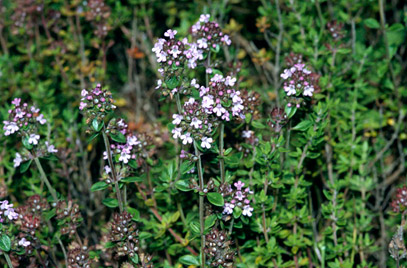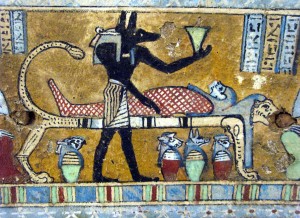What is Thyme?

Thyme is a perennial herb with many culinary and medicinal uses and is also valued for its aromatic qualities. Thyme is usually grown, dried and used as a spice. But the herb is can also be used as an oil and is utilized in aromatherapy and other herbal medical practices. Thyme belongs to the Lamiaceae (mint) family and is related to oregano. There is an abundance of varieties of thyme species and subspecies. The three main species of thyme used for culinary purposes are lemon thyme (thymus citridorus), caraway thyme (thymus herba-barona), and common thyme (thymus vulgaris).

History of Thyme
There a gargantuan amount of different varieties of thyme. Some of these varieties grow in some places but not others. But generally researchers concur that thyme originated in southern Europe and the Mediterranean region. The oldest recorded use of thyme was by the ancient Sumerians in 3000 B.C. who used the herb as an antiseptic (Bradbury). Thyme is connected to many ancient cultures along the Mediterranean. The ancient Egyptians used thyme for the embalming process and would sprinkle the herb between the layers of linen used to wrap the mummies.

The god Anubis preforming the ritual of enbalming
In ancient Greece, thyme was used in religious worship because of its rich and smoky scent. Also, thyme was seen as a sign of courage and soldiers would carry stems of thyme into battle with them. This tradition was carried on into Roman times and to Medieval times as well. Romans began to use thyme more for culinary purposes as ingredients in sauces and to season meat (Andrews). In Medieval times, thyme was put under pillows at night to ward off bad dreams as was used as medicine during the Black Plague (Rocky Mountain Spice Company).
Cultivation and Production
Warm, drier, sunnier areas are best for thyme cultivation. Watering the plant often is not necessary. The plant prefers drier soil because when the earth around it is excessively damp it is more susceptible to rot and diseases. Thyme is sturdy plant and can thrive in soils, such as rocky and sandy soil, where most plants can not grow. As the plant grows, it produces white or lilac-colored flowers which are usually picked off to allow more leaves to grow.
Thyme is grown in Poland, Turkey, Spain, Jordan, and Morocco. The United States imports a large part of their thyme from Turkey. But all imports arrive in the United States through Honduras. (US Aid)

Health Benefits of Thyme
There are an abundance of health benefits associated with consuming thyme. The plant has a large amount of antioxidants. It also has great deals of potassium, which helps control heart rate and blood pressure. Thyme contains a good amount of iron as well which is needed for red blood cell formation. Lastly, the herb has significant quantities of calcium, manganese, magnesium, vitamin – A , vitamin-K , vitamin-E, vitamin -C, which helps body resist infection, and dietary fiber (Wellness).
Thyme also has many healing qualities for a variety of illnesses or pains. Thyme contains a great quantity of thymol which is essential to fighting bodily infections and disinfecting cuts and scrapes. Thyme has also been found to be beneficial in aiding dental health, skin conditions, such as eczema, balancing hormones, and aiding with the common cold. Also it can used as a natural bug repellent. (Axe)

Use in the Arab Food
Za’atar is the Arabic word for thyme. But it can also be used to refer to a popular Middle Eastern spice blend which dates back to the Medieval Middle East. Generally, za’atar contains sumac, toasted sesame seeds, salt, cumin, dried oregano, dried marjoram, and of course dried thyme (LinsFood). But, the taste of za’atar can differ based on the region that it is made as well as personal preference. Za’atar is very versatile and used to season many different dishes or food items in Arab cuisine.

The za’atar spice mixture
Manakeesh

Manakeesh
Manakeesh is a very popular breakfast food, particularly in Lebanon, Syria, Jordan, and Palestine (Yunis). But is still commonly seen throughout all parts of the Arab world. It is essentially a flatbread that is the covered with a za’atar and oil mixture and then baked or cooked on a stove top and then served. There are some variations of manakeesh that are made with cheese, meat, or egg. But the most common form of manakeesh is the za’atar version (Mydubaimycity).
Cultural Significance
Za’atar is an integral part of Arab food culture and is considered a staple item in Arab cuisine. The taste and smell of the spice blend put people in mind of their home, their family, and their heritage. Syrian chef, Mohammed al-Khaldy describe the za’atar as important way to share his culture with French people of his new home (Carleton). Za’atar plays a big role in everyday life in the Arab world with mothers giving their children za’atar sandwiches before exams telling their children that it will make the smarter (Yunis). Another example of relationship between za’atar and the Lebanese people is shown through the enthusiasm of a man in Hrajel emphatically stating that consuming za’atar daily keeps the doctor away (Rahayel). Thyme has also taken on symbolic meaning in Arab society and is expressed through the arts (Yunis). This song, “Hands of Thyme and Stone” is from an album created by Lebanese composer Marcel Khalife and Palestinain poet, Mahmoud Darwish. Throughout the album and in this song, thyme expresses inner strength and the home (Yunis).
Works Cited
Andrews, Alfred C. “Thyme as a Condiment in the Graeco-Roman Era.” Osiris, vol. 13, 1958, pp. 150–156. JSTOR, JSTOR, http://www.jstor.org/stable/301647.
Axe , Josh. “5 Benefits of Thyme Essential Oil.” YouTube, YouTube, 26 July 2016, http://www.youtube.com/watch?v=I3cfxlrQOQE.
Bradbury, Kate. “The History of Herbs.” Herb Expert, Herb Expert, 1 Sept. 2012, http://www.herbexpert.co.uk/thehistoryofherbs.html.
Carleton, Marie-Helene. “Syrian Refugee Chefs Share Their Recipes.” Food | Al Jazeera, Al Jazeera, 9 July 2016, http://www.aljazeera.com/indepth/features/2016/06/syrian-refugee-chefs-share-recipes-160628081358083.html.
Darwish, Mahmoud. “Hands of Thyme and Stone.” YouTube, YouTube, 29 Apr. 2015, http://www.youtube.com/watch?v=KFBpuzQqMS8.
Foster, Kelli. “Sumac Gives You the Tang of Lemons Minus the Tartness.” Kitchn, Apartment Therapy, LLC., 1 Oct. 2016, http://www.thekitchn.com/inside-the-spice-cabinet-sumac-67042.
Foster, Kelli. “What’s the Difference Between Oregano and Marjoram?” Kitchn, Apartment Therapy, LLC., 12 Apr. 2017, http://www.thekitchn.com/whats-the-difference-between-oregano-and-marjoram-243310.
LinsFood. “Za’atar – a Middle Eastern Spice Mix.” YouTube, YouTube, 31 Aug. 2013, http://www.youtube.com/watch?v=wDH-YTKc7EY.
Mydubaimycity. “Suzanne’s Kitchen: Manaqeesh Zaatar and Jibneh (Flatbread with Dry Thyme and Cheese).” YouTube, YouTube, 22 Sept. 2013, http://www.youtube.com/watch?v=O_efAiDbZoc.
Rahayel, Anthony. “MANOUSHE: Lebanese World Renowned Traditional Breakfast.”YouTube, YouTube, 31 Oct. 2015, http://www.youtube.com/watch?v=zBRG01e7pxI.
Stahl-Biskup, Elisabeth, and Francisco SaÌez. Thyme: the Genus Thymus. Taylor and Francis, 2002.
“The History of Thyme | Myspicer | Wholesale Spices & Herbs.” MySpicer | Spices, Herbs, Seasonings, Rocky Mountain Spice Company, 28 May 2015, http://www.myspicer.com/the-history-of-thyme/.
The U.S. Market for Herbs. United States Agency for International Development, Dec. 2014, pdf.usaid.gov/pdf_docs/PA00KP2C.pdf.
“Thyme.” World Capital, World Capital Development and Management of Biological Agriculture Global Trading Co., worldcapital.gr/en/cultivations/aromatic-plants/thyme/.
Wellness. “Amazing Benefits of Thyme Herb – Health Benefits of Thyme Herb – Thyme Herb and Plants.” YouTube, YouTube, 25 Feb. 2016, http://www.youtube.com/watch?v=v-V6NwpJgYM.
Yunis, Alia. “Saudi Aramco World : Thyme Travels.” AramcoWorld, Aramco World , 2012, archive.aramcoworld.com/issue/201203/thyme.travels.htm.
“7 Amazing Thyme Benefits.” Organic Facts, Organic Information Services Pvt Ltd., 6 Oct. 2017, http://www.organicfacts.net/health-benefits/herbs-and-spices/thyme.html.
Images Cited
“Mummies and Mummification.” History in an Hour, 4 Nov. 2013, http://www.historyinanhour.com/2011/01/04/mummies-and-mummification/.
“Thymus Vulgaris.” Thymus Vulgaris | Common Thyme/RHS Gardening, http://www.rhs.org.uk/Plants/18213/i-Thymus-vulgaris-i/Details.
“Thymus Vulgaris.” Pfaf Plant Search, Plants for a Future, http://www.pfaf.org/user/Plant.aspx?LatinName=Thymus%2Bvulgaris.
Epicurious. “Za’atar.” Epicurious, Gourmet, 20 Aug. 2004, http://www.epicurious.com/recipes/food/views/zaatar-106776.
G, Srividhya. “Zaatar Pita Bread | Manakish Za’Atar Bread.” Vidhya’s Vegetarian Kitchen, Vidhya’s Vegetarian Kitchen, 30 Apr. 2017, http://www.vidhyashomecooking.com/2017/04/30/zaatar-pita-bread-manakish-zaatar-bread/.